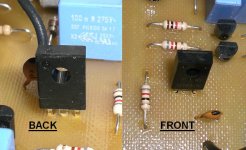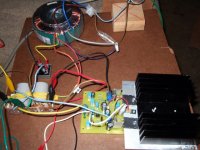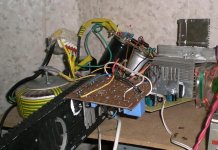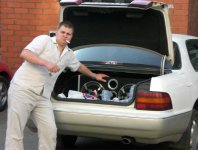Thank's for interest and support!
it is the same BD139.... and pinouts are the same. It just fully made from plastic.
These two transistors (same in Vbe) made me big headache... I was watching on them for 10min trying to figure out what is what
The only cue was it's name "BD139"... I thought that it is front.... i tried to prove my suspicion with nothing else like place on schematics
It was placed right and works perfect!
and works perfect!
regards,
microp
it is the same BD139.... and pinouts are the same. It just fully made from plastic.
These two transistors (same in Vbe) made me big headache... I was watching on them for 10min trying to figure out what is what
The only cue was it's name "BD139"... I thought that it is front.... i tried to prove my suspicion with nothing else like place on schematics
It was placed right
regards,
microp
Attachments
Progress. One board done and connected to a test PSU 25-0-25 with 6800uf per rail 
I can say with certainty that the 10r test resistors work
Power on, no flash, no bang, just the transformer humming. Humm, that means lots of current. Voltage across both the 10r resistors is about 27v, lucky they are 7 watt devices.
So, looks like something close to dead short. Main heatsink is isolated, I may have over cooked the drivers when soldering. Investigation in progress.
I can say with certainty that the 10r test resistors work
Power on, no flash, no bang, just the transformer humming. Humm, that means lots of current. Voltage across both the 10r resistors is about 27v, lucky they are 7 watt devices.
So, looks like something close to dead short. Main heatsink is isolated, I may have over cooked the drivers when soldering. Investigation in progress.
I had the same....
when i changed ps from 25-0-25 with 4700mFx2 per rail... to 36-0-36 with 2x22000mF per rail...
10r resistors were turned VERY ... extremely hot in few seconds
.... just turn your bias resistor and everything will be fine....
Your transistors will not burn because of resistors...
when i changed ps from 25-0-25 with 4700mFx2 per rail... to 36-0-36 with 2x22000mF per rail...
10r resistors were turned VERY ... extremely hot in few seconds
.... just turn your bias resistor and everything will be fine....
Your transistors will not burn because of resistors...
I did everithing like on Greg's website...
Set your bias trimpot to 770ohms and DC trimpot to 7400... Carlos told that it is most safely set for first start...
Carlos told that this regulations are perfect and keeps amp cool (pic).....
Enjoy..... great sonics Beautiful power!
Beautiful power!
Set your bias trimpot to 770ohms and DC trimpot to 7400... Carlos told that it is most safely set for first start...
Carlos told that this regulations are perfect and keeps amp cool (pic).....
Enjoy..... great sonics
Attachments
Genius microp, and Nordic and Carlos and everyone else here 
Most important to set the Vbias vr correctly, I set it before assembly but it looks like I set it the wrong way around. Always test and set before first power on.
So, not only does it work but it worked first time, if you ignore my small panic at having 2.7 amps across each resistor at start up.
Running 800mv across -ve about 90mv more across +ve. Offset is 0v +/- 3mv. Nothing is hot, the heatsinks on the tip's are just slightly warm. I'll leave it to cook while I sort out a speaker and source.
Most important to set the Vbias vr correctly, I set it before assembly but it looks like I set it the wrong way around. Always test and set before first power on.
So, not only does it work but it worked first time, if you ignore my small panic at having 2.7 amps across each resistor at start up.
Running 800mv across -ve about 90mv more across +ve. Offset is 0v +/- 3mv. Nothing is hot, the heatsinks on the tip's are just slightly warm. I'll leave it to cook while I sort out a speaker and source.
Good news Ecat!...thank you Nordic by the support..also thanks Graham and Microp
My dear Microp is now a Dx constructor, and now helping friends...this is very good.
I was sleeping after lunch, and you all took care of this thread.
I have to thank you all by the help and support.
Phong Vu Tuang had constructed and used, successfully, the Dx amplifier.... full volume...till he sent 40 watts speakers to hell.
Speakers, as i could see, are specified in something alike the IHF old rules...Institute of High Fidelity old rules.... a 40 watt speaker will not hold 40 watts RMS.... continuous power, above 20 watts will send that speaker to hell!
That ancient rule..... i think very bad used by some speaker manufacturers, said that to test a power amplifier you had to inject a very small time (very fast) boost of audio signal..... bigger than the needed to the amplifier...result was saturationg...if possible to read that in one scope..so fast it was that you had only a fast peak that needed the "hold function" to memorize it to latter readings....one channel only.... the lowest possible load for that amplifier under testing.
So...what you have....supply fully charged...condensers fat full of electrons.... only one channel receiving a "stratosferic " high level of signal entering...short time only... so... you gonna use your condensers charge to help during miliseconds.....the other channels not having consumption...so...the supply in its highest point!.... distortions gone to 20 percent or more.!
This presented some kind of numeric power that was more than twice the average power ...... sometimes the peak power obtained was 4 times the continuous power.
If you apply that idea to speakers...will result that a hundred watts speaker will hold 20 or 25 watts of continuous power.... and you can test it if you want to kill that unit...ahahahhahaha.
Observe that 8 volts of audio usually makes, a lot of speakers, reach the maximum compliance movement...more than that will make the coil hit the end....or the opposite..to jump out from the gap! ... so...as you can test in your home.......so... 15 watts or something bigger will be enought.. 15 clear watts.... if you go further...the speaker will not move further... this will produce some kind of acoustical square wave!
Acoustic power can be increase using many speakers!.... you gonna add area of speaker cone pumping air molecules...more are, more sound pressure into ears.... increase power above speaker limits will only distort and burn speakers.
People that wants power...loud audio...will be better aided using 10 speakers, 10 watts each one, connected series and parallel, than to use a single 100 watts unit.
Also..do not add another speaker to your enclosure...one speaker need that volume to work.... each speaker must use its own enclosure..
Well.... those were suggestions to Phong....my friend from Vietnam.
regards,
Carlos
............................................................................................................
Thank you by the image Ecat!
Very nice,...congratulations to you.... welcome to the Dx amplifier constructors crew.... all happy folks!
Your heatsink size is perfect!
Your construction was very clean Ecat...very good work!
regards,
Carlos
............................................................................................................
I have tried, after the Dx amplifier design (copy, adaptation..or the name you want to use..calculation was more correct) i have tested a lot of transistors as VAS.... including those small transistors used into electronic lamps... all them worked fine...beeing plastic, non plastic, bigger, small, fat, thin, black, gray or green ones.
This strange plastic unit, for sure will work there too.
VAS transistor is very important!...all the voltage the amplifier will present at the output will be generated in the VAS stage...the unit will sound fine if you use normal gain units (100).... will be nice if the unit presented low capacitance...it will need to hold 60 volts peak to peak, and more than 5 watts of power to be really safe...the better VAS transistor, the better your sonic result.
But i do not thing that a 200 Megahertz transistor is an advantage there!.... they will be more easy to start to oscilate...in special the terrible signal induced..or signal triggered oscilation.
regards,
Carlos
My dear Microp is now a Dx constructor, and now helping friends...this is very good.
I was sleeping after lunch, and you all took care of this thread.
I have to thank you all by the help and support.
Phong Vu Tuang had constructed and used, successfully, the Dx amplifier.... full volume...till he sent 40 watts speakers to hell.
Speakers, as i could see, are specified in something alike the IHF old rules...Institute of High Fidelity old rules.... a 40 watt speaker will not hold 40 watts RMS.... continuous power, above 20 watts will send that speaker to hell!
That ancient rule..... i think very bad used by some speaker manufacturers, said that to test a power amplifier you had to inject a very small time (very fast) boost of audio signal..... bigger than the needed to the amplifier...result was saturationg...if possible to read that in one scope..so fast it was that you had only a fast peak that needed the "hold function" to memorize it to latter readings....one channel only.... the lowest possible load for that amplifier under testing.
So...what you have....supply fully charged...condensers fat full of electrons.... only one channel receiving a "stratosferic " high level of signal entering...short time only... so... you gonna use your condensers charge to help during miliseconds.....the other channels not having consumption...so...the supply in its highest point!.... distortions gone to 20 percent or more.!
This presented some kind of numeric power that was more than twice the average power ...... sometimes the peak power obtained was 4 times the continuous power.
If you apply that idea to speakers...will result that a hundred watts speaker will hold 20 or 25 watts of continuous power.... and you can test it if you want to kill that unit...ahahahhahaha.
Observe that 8 volts of audio usually makes, a lot of speakers, reach the maximum compliance movement...more than that will make the coil hit the end....or the opposite..to jump out from the gap! ... so...as you can test in your home.......so... 15 watts or something bigger will be enought.. 15 clear watts.... if you go further...the speaker will not move further... this will produce some kind of acoustical square wave!
Acoustic power can be increase using many speakers!.... you gonna add area of speaker cone pumping air molecules...more are, more sound pressure into ears.... increase power above speaker limits will only distort and burn speakers.
People that wants power...loud audio...will be better aided using 10 speakers, 10 watts each one, connected series and parallel, than to use a single 100 watts unit.
Also..do not add another speaker to your enclosure...one speaker need that volume to work.... each speaker must use its own enclosure..
Well.... those were suggestions to Phong....my friend from Vietnam.
regards,
Carlos
............................................................................................................
Thank you by the image Ecat!
Very nice,...congratulations to you.... welcome to the Dx amplifier constructors crew.... all happy folks!
Your heatsink size is perfect!
Your construction was very clean Ecat...very good work!
regards,
Carlos
............................................................................................................
I have tried, after the Dx amplifier design (copy, adaptation..or the name you want to use..calculation was more correct) i have tested a lot of transistors as VAS.... including those small transistors used into electronic lamps... all them worked fine...beeing plastic, non plastic, bigger, small, fat, thin, black, gray or green ones.
This strange plastic unit, for sure will work there too.
VAS transistor is very important!...all the voltage the amplifier will present at the output will be generated in the VAS stage...the unit will sound fine if you use normal gain units (100).... will be nice if the unit presented low capacitance...it will need to hold 60 volts peak to peak, and more than 5 watts of power to be really safe...the better VAS transistor, the better your sonic result.
But i do not thing that a 200 Megahertz transistor is an advantage there!.... they will be more easy to start to oscilate...in special the terrible signal induced..or signal triggered oscilation.
regards,
Carlos
Microp...you pictures are excelent!
I have tried to send you files...but i think they do not reach you... was a 10 Megabytes Nakamichi slide movie with audio.
Even this new provider is not kind with me.
I hope you can turn your digital camera to take images from outside your window and send me.
I have to say that your images are turning better and better, as you are adapting yourself to the camera use.
Try 472 capacitor in parallel with R10...turn you volume to mid power and you will be in paradise..... this amplifier with some treble sounds very interesting...balances the strong bass it has.
Your BD139 image was very good!
panzertoo@yahoo.com
regards,
Carlos
I have tried to send you files...but i think they do not reach you... was a 10 Megabytes Nakamichi slide movie with audio.
Even this new provider is not kind with me.
I hope you can turn your digital camera to take images from outside your window and send me.
I have to say that your images are turning better and better, as you are adapting yourself to the camera use.
Try 472 capacitor in parallel with R10...turn you volume to mid power and you will be in paradise..... this amplifier with some treble sounds very interesting...balances the strong bass it has.
Your BD139 image was very good!
panzertoo@yahoo.com
regards,
Carlos
It is time........
do you ever imagine .... soon I will check how Dx is working with SMPS. I have a very nice brother. He want me to burn his subwoofer with Dx turbo... Soon I will show him the real power!!! The sub is about 400W rms @ 2ohms. No problems 4..5 pairs of transistors..... BOOOOOM!!!!
pic ...(brother.. lexus and sub)
do you ever imagine .... soon I will check how Dx is working with SMPS. I have a very nice brother. He want me to burn his subwoofer with Dx turbo... Soon I will show him the real power!!! The sub is about 400W rms @ 2ohms. No problems 4..5 pairs of transistors..... BOOOOOM!!!!
pic ...(brother.. lexus and sub)
Attachments
Destroyer X Amplifier...
Carlos
Shame on you ! Nobody doubts that your amplifiers are capable of this kind of power. BUT, to do this in a car , to your own brother is not a very good idea. If he is competing in one of those Car Audio Exhihibitions, fine. Not only is this kind of SPL from a car illegal over here, but may result in permanent, and severe hearing loss. It is also very antisocial in most neighbourhoods.
However, as purely a design exercise, it could be very interesting.
Kind Regards
SandyK
Carlos
Shame on you ! Nobody doubts that your amplifiers are capable of this kind of power. BUT, to do this in a car , to your own brother is not a very good idea. If he is competing in one of those Car Audio Exhihibitions, fine. Not only is this kind of SPL from a car illegal over here, but may result in permanent, and severe hearing loss. It is also very antisocial in most neighbourhoods.
However, as purely a design exercise, it could be very interesting.
Kind Regards
SandyK
Hi microp,
If your friend's car LS is 2 ohms, then maybe it is dual 4 ohm and has two sets of terminals.
From past experience I can assure you that better bass quality/damping is possible when you have one amplifier per 4 ohm winding, than by making an amplifier which is 2 ohms capable. Just run both amplifiers from the same input sounce. This is a better way of using/controlling the output transistors; say 2+2 per output stage.
Car bass loudspeaker systems tend to be much more reactive than those used for home hi-fi, so do not try to skimp on the number of output transistors used. This is why commercial designs use so many output devices.
Cheers ......... Graham.
If your friend's car LS is 2 ohms, then maybe it is dual 4 ohm and has two sets of terminals.
From past experience I can assure you that better bass quality/damping is possible when you have one amplifier per 4 ohm winding, than by making an amplifier which is 2 ohms capable. Just run both amplifiers from the same input sounce. This is a better way of using/controlling the output transistors; say 2+2 per output stage.
Car bass loudspeaker systems tend to be much more reactive than those used for home hi-fi, so do not try to skimp on the number of output transistors used. This is why commercial designs use so many output devices.
Cheers ......... Graham.
To test my construction I left my first DX running over night, nothing bad to report.
First quick listening test this morning using my PC as source and a single Rogers LS5 for output, a small speaker, not known for earth shaking base. Some of the music I have on the PC is beyond salvation but here are the highlights.
Gwen Stafani : Hollaback Girl
Justice is certainly done to whatever instrument is used for the sliding base effect. Drums and brass section are awesome.
T.A.T.U. : All The Things She Said.
Base, drums, acoustic guitar, synth, twin female vocals and rain. A track made for DX perhaps. This was my 'shivers' track, oh yes
Metallica : Whisky In The Jar
What can I say, forget any thoughts of objective listening. Party dude, this rocks !
Five more to build before I can use the big speakers and in all honesty, I cannot wait.
First quick listening test this morning using my PC as source and a single Rogers LS5 for output, a small speaker, not known for earth shaking base. Some of the music I have on the PC is beyond salvation but here are the highlights.
Gwen Stafani : Hollaback Girl
Justice is certainly done to whatever instrument is used for the sliding base effect. Drums and brass section are awesome.
T.A.T.U. : All The Things She Said.
Base, drums, acoustic guitar, synth, twin female vocals and rain. A track made for DX perhaps. This was my 'shivers' track, oh yes
Metallica : Whisky In The Jar
What can I say, forget any thoughts of objective listening. Party dude, this rocks !
Five more to build before I can use the big speakers and in all honesty, I cannot wait.
- Status
- Not open for further replies.
- Home
- Amplifiers
- Solid State
- Destroyer x Amplifier...Dx amp...my amplifier




